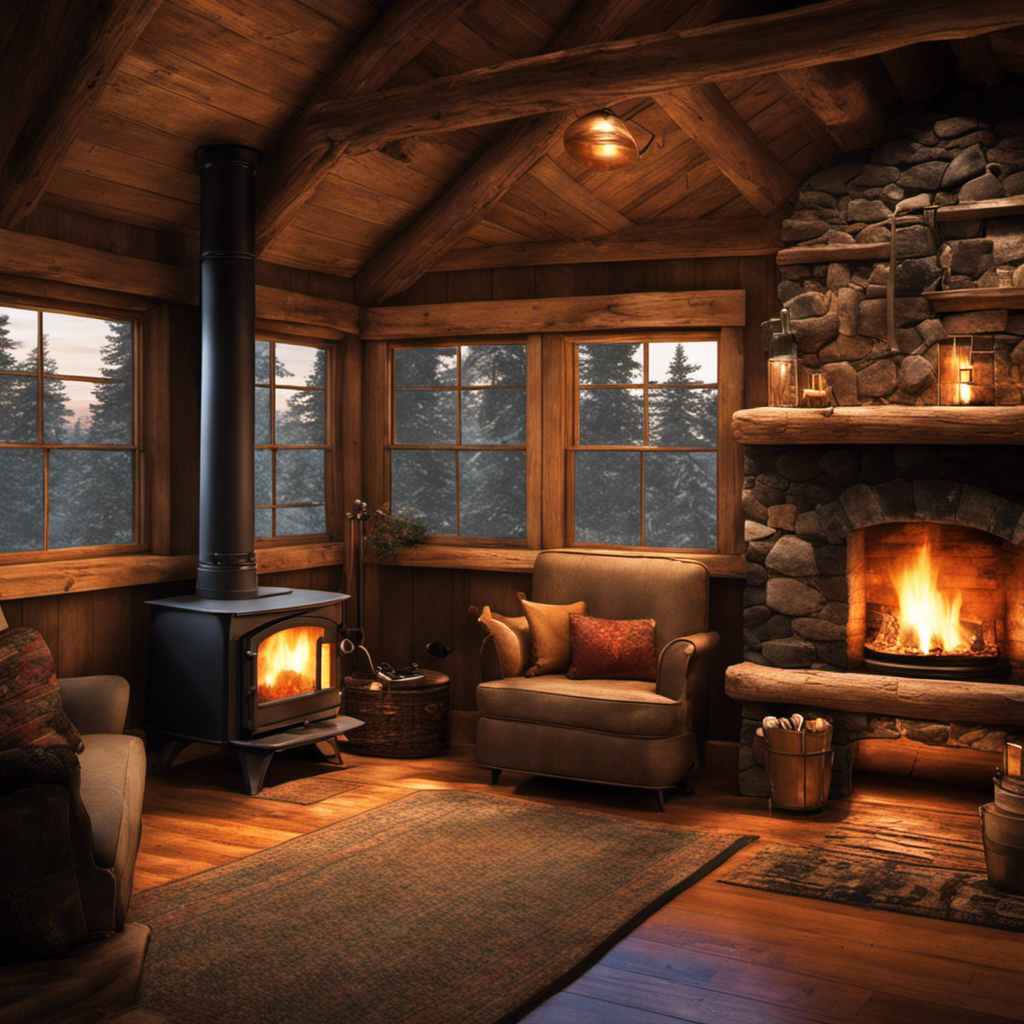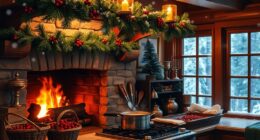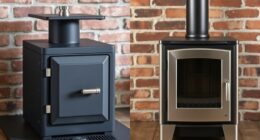Imagine cozy evenings spent huddled around a crackling fire, the warmth radiating through the rustic walls of your cabin. With our guide to wood stove installation, we’ll show you how to bring this comforting ambiance to your own rustic setting.
From choosing the right stove to ensuring proper safety precautions, our step-by-step instructions will help you create the perfect cabin retreat.
So grab a cup of hot cocoa and let’s get started on enhancing your cabin comfort with a wood stove.
Key Takeaways
- Consider wood stove efficiency and cost
- Measure the available space in the cabin and choose a stove that is the optimal size for the space
- Opt for a double-wall chimney system for proper venting and regularly inspect and clean the chimney
- Prioritize fire safety by regularly maintaining and cleaning the chimney, installing a spark arrestor, and using fire-resistant materials for a protective barrier.
Choosing the Right Wood Stove for Your Cabin
We’re looking for a wood stove that will fit perfectly in our cabin. When choosing a wood stove for your cabin, it’s important to consider wood stove efficiency and cost.
Efficiency is key because you want a stove that will effectively heat your space while minimizing fuel consumption. Look for wood stoves with high efficiency ratings, typically above 70%, as they’ll provide more heat with less wood. This won’t only save you money on fuel costs but also reduce your impact on the environment.
Cost considerations are also important when selecting a wood stove. The initial cost of the stove is just one part of the equation. You should also factor in the cost of installation, maintenance, and fuel. Some wood stoves may have higher upfront costs but offer long-term savings in terms of fuel efficiency and durability. Additionally, consider the size of your cabin and the heating needs of your space. You don’t want to overspend on a stove that’s too large for your cabin, as it will be less efficient and may cost more to operate.
Overall, when choosing a wood stove for your cabin, prioritize wood stove efficiency and cost considerations. By doing so, you’ll find a stove that fits perfectly in your space, provides optimal heat output, and helps you save money in the long run.
Sizing and Placement Considerations for Wood Stove Installation
When it comes to installing a wood stove, there are a few important considerations to keep in mind.
First, you want to ensure that the stove is the optimal size for your space, as this will affect its efficiency and heat output.
Additionally, the placement of the stove is crucial for both safety and effectiveness, so it’s important to choose an ideal location that allows for proper ventilation and heat distribution.
Optimal Stove Size
Our first step in determining the optimal stove size is to measure the available space in the cabin. This measurement will help us calculate the heat requirements for the room.
To ensure energy efficiency, it’s important to choose a stove that isn’t too small or too large for the space. A stove that’s too small may not provide sufficient heat, while a stove that’s too large can lead to excessive heat production and wasted energy.
Consider the insulation and layout of the cabin when calculating the heat needs. A well-insulated cabin may require a smaller stove, while a cabin with poor insulation may require a larger one.
Ideal Placement Location
After considering the insulation and layout, we found the ideal placement location for the stove.
When it comes to wood stove installation in rustic cabin settings, ventilation requirements and clearance regulations are of utmost importance. Proper ventilation ensures that the cabin remains safe and comfortable, while clearance regulations prevent any fire hazards.
For ventilation requirements, it’s crucial to have a direct source of fresh air intake near the stove. This can be achieved by installing a vent pipe that extends outside the cabin.
As for clearance regulations, it’s essential to follow the manufacturer’s guidelines to ensure proper distance between the stove and combustible materials such as walls, furniture, and curtains. By adhering to these regulations, you can enjoy the warmth and coziness of a wood stove while ensuring the safety of your rustic cabin.
Now, let’s dive into the next section about chimney and venting options for rustic cabin settings.
Chimney and Venting Options for Rustic Cabin Settings
In our rustic cabin, we opted for a double wall chimney system to ensure proper venting for our wood stove.
Chimney maintenance is crucial to keep the system functioning efficiently and to avoid potential hazards. Regular inspection and cleaning are necessary to remove creosote buildup, which can lead to chimney fires. It’s recommended to have a professional chimney sweep perform this task at least once a year.
Additionally, it’s important to adhere to venting regulations to ensure the safe operation of your wood stove. These regulations may vary depending on your location, so it’s essential to consult local building codes or hire a professional to ensure compliance.
Proper venting helps to prevent the buildup of carbon monoxide and other harmful gases inside your cabin. With a well-maintained chimney and proper venting, you can enjoy the warmth and coziness of your wood stove without compromising your safety.
Now, let’s move on to the next section where we’ll discuss safety precautions and fireproofing your cabin to further enhance your wood stove experience.
Safety Precautions and Fireproofing Your Cabin
Now that we’ve discussed the chimney and venting options for rustic cabin settings, it’s important to focus on safety precautions and fireproofing your cabin. Fire safety should be a top priority when installing a wood stove, as it can greatly reduce the risk of chimney fires and other potential hazards.
One of the key measures to prevent chimney fires is regular chimney maintenance and cleaning. It’s recommended to have your chimney inspected and cleaned at least once a year by a professional chimney sweep. This ensures that any creosote buildup or obstructions are removed, reducing the chances of a fire starting in the chimney.
To further enhance fire safety, it’s essential to install a spark arrestor on top of the chimney. This simple device prevents sparks and embers from escaping and potentially igniting nearby combustible materials.
Additionally, consider installing a fireproof barrier around the wood stove. This can be achieved by using materials such as fire-resistant bricks or tiles to create a protective wall or hearth. This barrier helps to prevent accidental contact with flammable materials and adds an extra layer of safety to your cabin.
By following these safety precautions and fireproofing your cabin, you can enjoy the warmth and comfort of your wood stove while minimizing the risk of fire.
Now let’s move on to the next section, where we’ll discuss the tools and materials needed for wood stove installation.
Tools and Materials Needed for Wood Stove Installation
As we discuss the tools and materials needed for installing a wood stove, it’s essential to have the proper equipment and supplies ready for a successful installation.
When it comes to the installation process, there are several tools and equipment that you’ll need to have on hand. Firstly, you’ll need a tape measure to accurately measure the space where the wood stove will be installed. This will ensure that the stove fits properly and meets all safety requirements.
Next, you’ll need a level to ensure that the stove is installed on a level surface. This is crucial for the stove’s performance and longevity. Additionally, you’ll need a drill with various drill bits to create the necessary holes for venting and attaching the stovepipe. A screwdriver and wrench will also come in handy for tightening screws and bolts during the installation process.
Lastly, you’ll need fireproof materials such as heat-resistant insulation, fireproof cement, and stove boards to protect the surrounding walls and floors from heat and potential fire hazards.
Step-by-Step Guide to Installing a Wood Stove in Your Cabin
When installing a wood stove, we need to carefully follow a step-by-step guide to ensure a successful installation in our cozy cabin. Not only does this keep us warm during those cold winter nights, but it also adds a rustic charm to our living space.
Before beginning the installation process, it’s important to check the wood stove regulations in our area. These regulations vary, so it’s crucial to know the specific requirements for our location. Additionally, we should consider the cost of wood stove installation. This includes the price of the stove itself, as well as any necessary accessories and professional installation fees. By researching and budgeting for these expenses ahead of time, we can avoid any unexpected financial burdens.
Once we’ve confirmed the regulations and budgeted accordingly, we can proceed with the step-by-step installation process. This typically involves preparing the installation area, assembling and positioning the stove, connecting the stove to the chimney, and ensuring proper ventilation. Following these steps diligently will ensure a safe and efficient wood stove installation in our cabin.
Proper Maintenance and Cleaning of Your Wood Stove
To ensure our wood stove functions properly and remains in good condition, we must regularly maintain and clean it. Proper maintenance and cleaning are essential for the longevity and efficiency of our wood stove. Here are some maintenance tips and cleaning techniques to keep our wood stove in top shape:
| Maintenance Tips | Cleaning Techniques |
|---|---|
| Regularly inspect the stove for any damage | Clean the stovepipe and chimney regularly |
| Check the gaskets for wear and tear | Remove ashes and soot buildup from the stove |
| Ensure proper airflow by cleaning the air vents | Clean the glass door to maintain visibility |
Inspecting the stove for any damage is crucial to catch any issues early on. This includes checking the gaskets for any signs of wear and tear, as they play a vital role in ensuring a tight seal. Cleaning the stovepipe and chimney regularly is essential to prevent creosote buildup, which can lead to chimney fires. Removing ashes and soot buildup from the stove helps maintain optimal airflow and prevents any blockages. Additionally, cleaning the glass door regularly will keep it looking clean and maintain visibility of the fire.
Troubleshooting Common Issues With Wood Stove Installation
We should address common issues that may arise during the installation of our wood stove. Proper installation is crucial to ensure the stove operates efficiently and safely. Here are some troubleshooting tips to help you overcome potential problems:
- Drafty Stove:
- Check the door gasket: A worn-out or damaged door gasket can result in air leaks. Replace it if necessary.
- Inspect the chimney: Make sure it’s properly sealed and free from any blockages that could cause drafts.
Preventing Creosote Buildup:
- Burn dry wood: Wet or unseasoned wood produces more smoke and increases the chance of creosote buildup. Use only well-seasoned wood.
- Regular chimney cleaning: Creosote buildup is a common cause of chimney fires. Schedule regular cleanings to remove any creosote deposits.
- Monitor air intake: Adjust the air intake to maintain a clean and efficient burn. Too much air can lead to a cooler chimney, increasing the chances of creosote formation.
Enhancing Cabin Comfort With Wood Stove Accessories
One way we can enhance our cozy cabin experience is by adding accessories that complement our wood stove. These wood stove accessories not only improve the functionality of our stove but also contribute to the overall ambiance of our cabin. By carefully selecting the right accessories, we can create a warm and inviting atmosphere, perfect for those chilly winter nights.
Here are some wood stove accessories that can greatly improve our cabin ambiance:
| Accessory | Description |
|---|---|
| Stove Fan | A stove fan helps to circulate the warm air generated by the wood stove, distributing it more evenly throughout the cabin. This not only increases the efficiency of our stove but also ensures that every corner of our cabin is kept warm and cozy. |
| Firewood Rack | A firewood rack is a practical and stylish addition to our cabin. It keeps our firewood organized and easily accessible, while also adding a rustic touch to our space. |
| Hearth Rug | A hearth rug not only protects our flooring from sparks and embers but also adds a touch of comfort and beauty to our wood stove area. It provides a soft and cozy spot to sit beside the fire, enhancing the overall relaxation and warmth of our cabin. |
Frequently Asked Questions
Can I Install a Wood Stove in a Non-Rustic Cabin Setting?
Yes, you can definitely install a wood stove in a non-rustic cabin setting.
There are alternative wood stove options available that can be suitable for any type of cabin.
The benefits of wood stove installation in non-rustic settings include efficient heating, cost savings, and adding a cozy ambiance to your cabin.
It’s important to consider the specific requirements and regulations for your area, as well as consult with a professional to ensure proper installation and safety.
What Are the Potential Health Risks Associated With Wood Stove Installation?
Indoor air pollution from wood stove installation can have potential long-term effects on our health. It’s important to be aware of the risks associated with this type of heating.
Breathing in smoke and pollutants can lead to respiratory issues, such as asthma and bronchitis. Additionally, exposure to carbon monoxide can be life-threatening.
Proper ventilation and regular maintenance of the stove can help minimize these risks. Stay informed and take necessary precautions for a safe and comfortable living environment.
How Can I Ensure That My Wood Stove Is Energy Efficient?
When it comes to ensuring energy efficiency for your wood stove, there are a few key factors to consider.
First, proper insulation is crucial for maximizing efficiency. Make sure your cabin is well-insulated to prevent heat loss.
Second, choosing the right wood is important. Opt for hardwoods like oak or maple, as they burn longer and produce more heat.
Are There Any Regulations or Permits Required for Wood Stove Installation in Rustic Settings?
When it comes to wood stove installation in rustic settings, it’s important to be aware of the regulations and permits that may be required. These rules are put in place to ensure the safety and compliance of the installation process.
Depending on your location and the specific rustic setting, there may be different requirements in terms of permits and inspections. It’s crucial to research and understand these regulations before proceeding with your wood stove installation.
Can I Use My Wood Stove for Cooking or Heating Water in Addition to Heating My Cabin?
Yes, you can use your wood stove for cooking or heating water in addition to heating your cabin.
Wood stoves are versatile and efficient for these purposes. They provide a great source of heat for cooking, allowing you to prepare meals and boil water.
Additionally, some wood stoves come with built-in water heating features, which can be used to heat water for various purposes. This adds to the convenience and practicality of having a wood stove in your rustic setting.
Conclusion
In conclusion, installing a wood stove in your rustic cabin can greatly enhance your comfort and create a cozy atmosphere. By choosing the right stove, considering placement and sizing, and ensuring proper ventilation and safety measures, you can enjoy the warmth and charm of a wood-burning fire.
With regular maintenance and troubleshooting, you can keep your wood stove running efficiently and prolong its lifespan. Don’t forget to explore accessories that can enhance your cabin experience even further.
Stay warm and enjoy the rustic charm of your wood stove!





